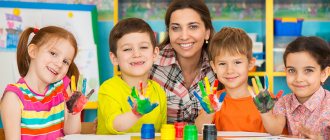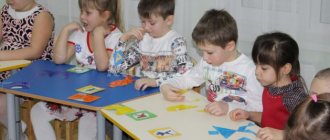Workshop “Health-saving technologies in preschool educational institutions”
Workshop “Health-saving technologies in working with children”
Let's start our seminar with games that can be used in working with children. Teachers stand in a circle.
Game “Greeting” Say hello to each other by the hand, shoulders, backs, say hello to those who are wearing trousers, dresses, etc.
Game "Pass the Signal". Teachers join hands. The presenter sends a signal to the person standing next to him through a handshake. When the signal comes back to the leader, he raises his hand and reports that the signal has been received.
Slide 2.
Popular wisdom says: “Health is a priceless gift; if you lose it in youth, you will not find it until old age.”
Unfortunately, in our fast-paced age of new technologies, research and development, the problem of maintaining health is very acute. The statistics are sounding the alarm. Many reasons are beyond our control and we cannot change anything. But there is one, in my opinion, very important - this is the formation in preschool children of the need to preserve and strengthen their health. Only physically developed and practically healthy children achieve success and heights of knowledge of the world.
Health is not only the absence of disease, it is a state of optimal performance, creative output, emotional tone, that which creates the foundation for the future well-being of an individual.
What does a child’s health depend on?
Statistics say that 20% from hereditary factors, 20% from environmental conditions, i.e. ecology, 10% from the activities of the healthcare system, and 50% from the person himself, from the lifestyle that he leads.
If we, teachers, cannot influence the first 50% of health, then we can and should give the other 50% to our students.
Health-saving technologies are a systematically organized set of programs, techniques, methods of organizing the educational process, aimed at strengthening and preserving the health of children; qualitative characteristics of educational technologies based on the criterion of their impact on the health of students and teachers; technological basis of health-saving pedagogy.
Slide 3.
HEALTH TASKS:
• preserve the health of children;
• create conditions for their timely and full mental development;
• provide every child with the opportunity to joyfully and meaningfully live the period of preschool childhood.
Slide 4.
Modern health-saving technologies
To date, leading psychologists, teachers and medical professionals have created many different health-saving techniques that can be classified into several separate groups. These are medical, preventive and physical education technologies, health-saving technologies for preschool teachers, technologies aimed at ensuring the socio-psychological well-being of pupils, and valeological education of children and parents.
1. Technologies for preserving and promoting health
Slide 5.
Stretching - stretching exercises are useful and necessary for everyone, regardless of age and degree of flexibility. This should be done no earlier than 30 minutes later. after meals, 2 times a week for 30 minutes. from middle age in physical education or music halls or in a group room, in a well-ventilated area. Recommended for children with sluggish posture and flat feet. Beware of disproportionate stress on the muscles.
Slide 6.
Rhythmoplasty is a system of physical exercises aimed at the comprehensive harmonious development of the body. Rhythmoplasty combines two areas: physical education and choreography. Not earlier than in 30 minutes. after meals, 2 times a week for 30 minutes. from middle age. Pay attention to the artistic value, the amount of physical activity and its proportionality to the child’s age.
Slide 7.
Dynamic pauses - During classes, 2-5 minutes, as children get tired. Recommended for all children as a preventive measure against fatigue. May include elements of eye exercises, breathing exercises and others, depending on the type of activity.
Slide 12.
Outdoor and sports games - As part of a physical education lesson, on a walk, in a group room - small with an average degree of mobility. Daily for all age groups. Games are selected according to the age of the child, the place and time of the game. In preschool educational institutions we use only elements of sports games.
HEALTH PATH
An approximate set of exercises for any age.
Light up the “sun” within yourself: jump, clap your hands, saying: joy, joy, joy.
Embrace the sky: stretch up, raise your toes, spread your arms to the sides, connect them on your chest.
Bow to Mother Earth to the floor.
Draw waves with your arms spread to the sides.
Become a windmill (make large circles with your hands on both sides of your body)
Make a circle of friendship. Hugging your shoulders, swaying, saying: “May the world be good because you and I exist.”
Get into a “tight fist”:
Seed of health
| 1) hardening, barefooting and swimming | (at the choice of the teacher, by agreement with the parents, once a month, full day) |
| 2) walks and hikes - the teacher provides one hour of sports breathing | (daily outdoors (with an excursion to a museum, exhibition, parks)) |
| 3) ways to maintain health and self-regulation (little valeologists) | (depending on the situation, as often as possible) |
| 4) games with jumping rope or exercise equipment | (daily) |
| 5) special and intense exercises | (required for gymnastics) |
Slide 13.
Relaxation - In any suitable room. Depending on the condition of the children and goals, the teacher determines the intensity of the technology. For all age groups. You can use calm classical music (Tchaikovsky, Rachmaninov, sounds of nature.
Slide 14.
Finger gymnastics - From a young age, individually or with a subgroup daily. Recommended for all children, especially those with speech problems. Conducted at any convenient time (at any convenient time)
Gymnastics for the eyes - Daily for 3-5 minutes. at any free time; depending on the intensity of visual load from a young age. It is recommended to use visual material and demonstration by the teacher.
Breathing gymnastics - In various forms of physical education and health work. Ensure the room is ventilated and the teacher give children instructions on mandatory nasal hygiene before the procedure.
Invigorating gymnastics - Every day after a nap, 5-10 minutes. The form of implementation is different: exercises on beds, extensive washing; walking on ribbed planks; easy running from the bedroom to a group with a difference in temperature in the rooms and others depending on the conditions of the preschool educational institution.
Corrective gymnastics - In various forms of physical education and health work. The form of implementation depends on the task and the number of children.
Orthopedic gymnastics - In various forms of physical education and health work. Recommended for children with flat feet and as a prevention of diseases of the supporting arch of the foot.
Slide 18.
2. Technologies for teaching a healthy lifestyle
Physical education - 2-3 times a week in a sports hall or music hall. Early age - in a group room, 10 min. Young age - 15 minutes, middle age - 20 minutes, older age - 25-30 minutes. Classes are conducted in accordance with the program according to which the preschool educational institution operates. Before class, it is necessary to ventilate the room well.
Problem-based games (game training and game therapy) - In your free time, possible in the afternoon. The time is not strictly fixed, depending on the tasks set by the teacher. The lesson can be organized unnoticed by the child, by including the teacher in the process of play activity.
Communication games - 1-2 times a week for 30 minutes. from an older age. Classes are structured according to a specific scheme and consist of several parts. They include conversations, sketches and games of varying degrees of mobility, drawing, modeling, etc.
Classes from the “Health” series - once a week for 30 minutes. from Art. age. Can be included in the lesson schedule as cognitive development.
Self-massage - Depending on the goals set by the teacher, in sessions or in various forms of physical education and health work. It is necessary to explain to the child the seriousness of the procedure and give children basic knowledge of how not to harm their body
Acupressure self-massage - Carried out on the eve of epidemics, in the autumn and spring periods at any time convenient for the teacher from an older age. It is carried out strictly according to a special technique. Indicated for children with frequent colds and diseases of the ENT organs. Visual material is used.
Aromatherapy is a treatment using different scents. These smells, or aromas, in the form of essential oils come to us from the plant world - from flowers, trees, shrubs and herbs.
Aromatherapy exists not only to treat an already developed disease. It is also a very real protection against various bacteria and viruses.
The use of aromatherapy in a children's room will help maintain a good mood in children, and also help cure colds and sleep disorders.
Children love warm, sweet smells most. However, due to the fact that their body is still in a state of development, aromatherapy products should be used for them in very minimal dosages. It is best if the oils are applied to clay or glass figurines, aroma medallions, and pillows. Various products made from untreated wood, orange or grapefruit peels hold odors well. This method is used to aromatize the air in a children's room.
Aromatherapy is not recommended for children under 2-2.5 years of age.
Slide 19.
3. Corrective technologies
Art therapy is treatment, healing, development through any creative activity. Simply put, if a person has accumulated experiences, he can express them through creativity (a drawing or a craft, a fairy tale) and feel relief. This is art therapy. Sessions of 10-12 lessons for 30-35 minutes. from the middle group.
Classes are conducted in subgroups of 10-13 people, the program has diagnostic tools and involves training protocols.
Technologies of musical influence - In various forms of physical education and health work; or separate classes 2-4 times a month depending on your goals
Used as an aid as part of other technologies; to relieve stress, increase emotional mood, etc.
Fairytale therapy - 2-4 lessons per month, 30 minutes each. from an older age.
Classes are used for psychological therapeutic and developmental work. The story can be told by an adult, or it can be a group story, where the narrator is not one person, but a group of children.
Technologies of color influence (color therapy) - As a special lesson 2-4 times a month, depending on the tasks. It is necessary to pay special attention to the color scheme of the interiors of preschool educational institutions. Properly selected colors relieve tension and increase a child’s emotional mood.
Psycho-gymnastics - 1-2 times a week from older ages for 25-30 minutes.
Classes are conducted using special methods.
Game "Applause for each other"
Goal: relieve tension and fatigue, thank all participants for their work. The presenter begins to clap his hands and looks at one of the participants. The two of them start clapping. The participant whom the presenter looked at looks at the other participant, including him in the game. Thus, all participants begin to clap.
Today, preserving and strengthening children’s health is one of the main strategic objectives of the country’s development.
The art of living long consists, first of all, in learning to take care of your health from childhood. What is missed in childhood is difficult to make up for.
Municipal state preschool educational institution
d/s No. 83, Rossoshi
Workshop
“Health-saving technologies in working with children in preschool educational institutions”
Educator: Sycheva S.I.


